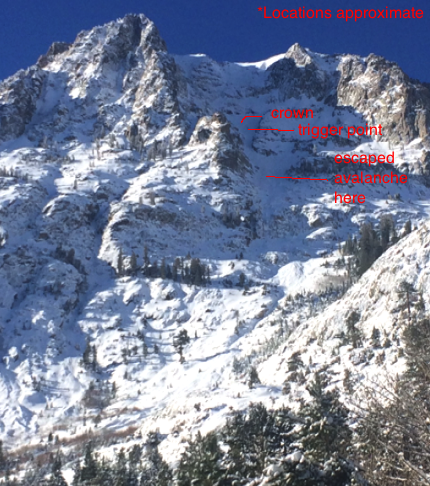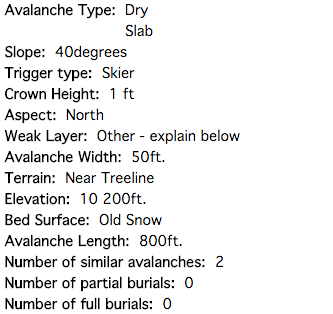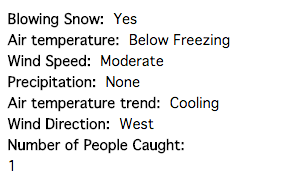
A skier triggered an avalanche and was carried 300-400 feet down a very steep (40º) section of “Pete’s Dream” in the Eastern Sierra Nevada mountains of California yesterday. He broke his ankle in the avalanche. He was able to fight his way out of the avalanche and save his own life as the avalanche ended up flying over large cliffs.
“This [the avalanche] swept him off his feet, carried him violently down the chute for approximately 300-400 vertical feet, smashed him into a diagonal rockwall breaking his ankle, before he was able to fight his way back ontop of his skis and make it left out of the avalanche to a zone of safety as the avalanche continued down-slope and over large cliffs.”
This is his story:

Skier caught/injured – Avalanche on Carson Peak – Pete’s Dream
by Eastern Sierra Avalanche Center
3 expert skiers and 1 expert snowboarder set out on Tuesday morning, March 8th, with intentions to check out Pete’s Dream, an exposed technical north facing line on Carson Peak. This line requires tricky route finding and several sections of down climbing through rocks. 2 of the skiers and the snowboarder had ridden this line numerous times in previous years. For one of the skiers it would be his first time. All 4 were expert skier/riders, in their late 30s to mid 40s, all with many years of backcountry experience in challenging mountain terrain throughout the Sierra, North America, and the world.
One of the skiers had skied the nearby negatives off the San Juaquin Ridge behind June Mtn the day before, and had made note of mostly stable conditions, despite the recent dump of 1-2ft of new snow Sat night/Sunday morning, 1-2″ on new snow Monday night, and associated strong winds predominantly out of the SW. A more detailed history of the recent winds: The winds were strong from the SW during the storm and eased somewhat to moderate force during the day Sunday as they shifted back and forth from SE to SW, to a period of very light southerly winds Monday morning, until the winds shifted out of the north early afternoon, and persisted moderately from the north through the day. They calmed quite a bit again by Tuesday morning. Recent nearby avalanche history: A very active natural cycle of avalanches took place throughout the region mostly early Sunday morning during the intense snow and windload period.
The party viewed the line from the road Tuesday morning, and noted evidence that the line had slid naturally very recently, as evidenced by debris they could see 2/3 of the way up. This gave them a sense of reassurance that avalanche danger would be now lessened as they could see it had already slid. The party approached from June Mtn, climbed to the top of Carson peak via the back, and began their descent around 12:30pm. By this time, winds had increased, mostly out of the West, and appeared swirly across this face, decreasing visibility at times. A top ski cut resulted in a notable small avalanche. Further down the line, another ski cut produced a larger avalanche with ~8-10” crown which extended across the slope wall to wall, stepped down deeper part way down the slope, and appeared to “clean-out” the majority of the line below. This result again gave the party a sense of reassurance that since the line appeared to now be freshly “cleaned out”, that avalanche danger from the recent wind-load would be diminished below. They skied the line as cautiously as they could, one at a time, from anchor point to anchor point.
Around 1:30pm, half way down this line at approximately 10,200’, the party came to a narrow choke section with a slope of about 40 degrees. 2 skiers skied thru safely one at a time and anchored up in safe location below. The 3rd skier was part way down when he triggered a slope failure which propagated about 100ft above him releasing a slab avalanche with a crown of 14-18” across the width of the slope (~50ft wide). This swept him off his feet, carried him violently down the chute for approximately 300-400 vertical feet, smashed him into a diagonal rockwall breaking his ankle, before he was able to fight his way back ontop of his skis and make it left out of the avalanche to a zone of safety as the avalanche continued down-slope and over large cliffs. This avalanche was triggered when the 3rd skier presumably hit a “sweet spot” where the overlying wind slab was less thick and the weight and force of his skiing was enough to penetrate through and cause a failure in the weakness between this newer windslab and the underlying snow. This failure propagated uphill and caused the slope above him to fail which all 3 skiers had already skied down. Also of note, injured skier using dynafit bindings, with toe in “locked up” position. Both heals of bindings released, but toes did not. Perhaps if ski had completely released he wouldn’t have had ankle broken, but also he may not have been able to ski out of avalanche, and very likely could have been swept over cliffs resulting in much worse injury or death.

The snowboarder descended, the party regrouped, and they initiated a call to Search and Rescue and a helicopter evacuation. The injured skier was able to ski down with assistance from the others to an area they believed a helicopter would be able to access. Of note during this part of the decent, the party kicked off numerous additional very sensitive small windlsab avalanches (crowns 4-6”). After 30-45minutes of huddling together trying unsuccessfully to keep the injured skier warm, the party decided that based on the windy conditions and the uncertainty of how long a helicopter would take to arrive (and if it did if it would actually be able to assist them in these windy conditions) they decided to self-evacuate. Despite being in immense pain, the injured skier was able to make it down this challenging terrain on one ski with the assistance of his partners, until they met search and rescue personnel with a rescue litter a few hundred yards above double eagle resort. It took approximately 4 hours from the time of the accident to the time the injured skier was in an ambulance.
What led these skilled and accomplished skiers and riders into deciding to put themselves into this risky situation? This is a question that is asked after most avalanche accidents in the backcountry. This is an important and ongoing discussion, but is beyond the scope of this report at this time. It is easy for both the people involved in these types of accidents, and the un-involved public, to criticize and judge after the fact. Instead, I urge everyone with an interest to learn from this kind of event. Think about the complex human factors that are involved in making decisions in the mountains. Become more aware of your own decision making process and how emotions can almost unavoidably become involved. And recognize how vastly these human factors can vary for different people and in different dynamic social group situations.




gets lucky
The signs were everywhere. It’s hard to call this an accident….